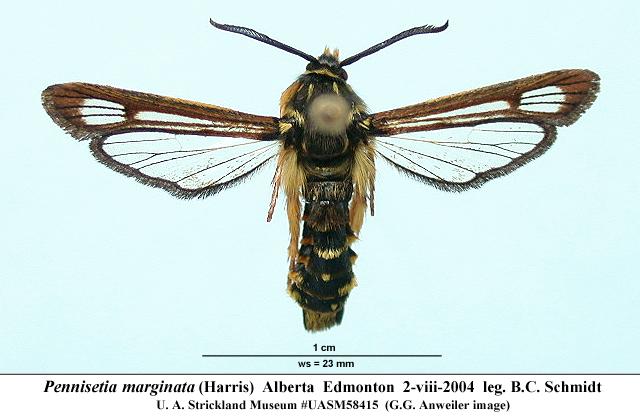Species Details
Pennisetia marginata
University of Alberta E.H. Strickland Entomological Museum Read more about this collection »
SeasonalityAdults fly in Alberta July and early August.
IdentificationA small (2.0- 3.5 cm wingspan) wasp-like clear-wing moth. Females are much larger than males. The body is black, with some yellow streaking and 4 or more narrow yellow bands around the abdomen. The legs are largely dull yellow. The wings, where scaled, are dark olive and red-brown, and there is a prominent dark discal bar. Males are easy to separate from other Alberta sesiids as this is the only species with bipectinate antennae. Females are smaller than other yellow-banded Alberta sesiids, and the wing pattern is noticeable different. Closely related to but apparently distinct from the Palearctic P. hylaeformis Laspeyres.
Scientific Name
Pennisetia marginata
Habitat
Associated with Raspberry (Rubus, including garden plantations.
Seasonality
Adults fly in Alberta July and early August.
Identification
A small (2.0- 3.5 cm wingspan) wasp-like clear-wing moth. Females are much larger than males. The body is black, with some yellow streaking and 4 or more narrow yellow bands around the abdomen. The legs are largely…
A small (2.0- 3.5 cm wingspan) wasp-like clear-wing moth. Females are much larger than males. The body is black, with some yellow streaking and 4 or more narrow yellow bands around the abdomen. The legs are largely dull yellow. The wings, where scaled, are dark olive and red-brown, and there is a prominent dark discal bar. Males are easy to separate from other Alberta sesiids as this is the only species with bipectinate antennae. Females are smaller than other yellow-banded Alberta sesiids, and the wing pattern is noticeable different. Closely related to but apparently distinct from the Palearctic P. hylaeformis Laspeyres.
Life History
A borer in the roots and root crowns of Rubus sp. Although some complete the life cycle in a single year, most require two years to complete development. Adults are diurnal. Although a pest in commercial plantations…
A borer in the roots and root crowns of Rubus sp. Although some complete the life cycle in a single year, most require two years to complete development. Adults are diurnal. Although a pest in commercial plantations in some areas, it is apparently uncommon in Alberta and thus of little significance.
Conservation
Uncommon in Alberta; elsewhere may achieve pest status.
Diet Info
The larvae are borers in the rootstock and root crowns of raspberry and blackberry (Rubus sp.)
Range
Widespread in the United States, and in particular in the east and along the Pacific Coast, ranging north into the southern parts of Canada. In Alberta it has been found north to Edmonton and Nordegg.
References
Author
Bowman, K.
Title
An annotated list of the Lepidoptera of Alberta.
Publication Date
1951
Series Title
Canadian Journal of Zoology
Volume
29
Pages
121-165
Author
Eichlin, T.D. and W.D. Duckworth
Title
Sesioidea, Sesiidae
Publication Date
1988
Specimen Information
There are 5 specimens of this Species.
UASM49521 - Pennisetia marginata
University of Alberta E.H. Strickland Entomological Museum
Place CollectedCanada: Alberta, Edmonton
Collected ByFuller, E. R.
Date Collected1994-08-13
UASM58415 - Pennisetia marginata
University of Alberta E.H. Strickland Entomological Museum
Place CollectedCanada: Alberta, Edmonton
Collected BySchmidt, B. C.
Date Collected2004-08-02
BIRD17203 - Pennisetia marginata
University of Alberta E.H. Strickland Entomological Museum
Place CollectedCanada: Alberta, Erskine
Collected ByBird, C. D.
Date Collected2006-07-04
BIRD17204 - Pennisetia marginata
University of Alberta E.H. Strickland Entomological Museum
Place CollectedCanada: Alberta, Erskine
Collected ByBird, C. D.
Date Collected2006-07-13
UASM99250 - Pennisetia marginata
University of Alberta E.H. Strickland Entomological Museum
Place CollectedCanada: Alberta, Lethbridge
Date Collected1989-08-20
